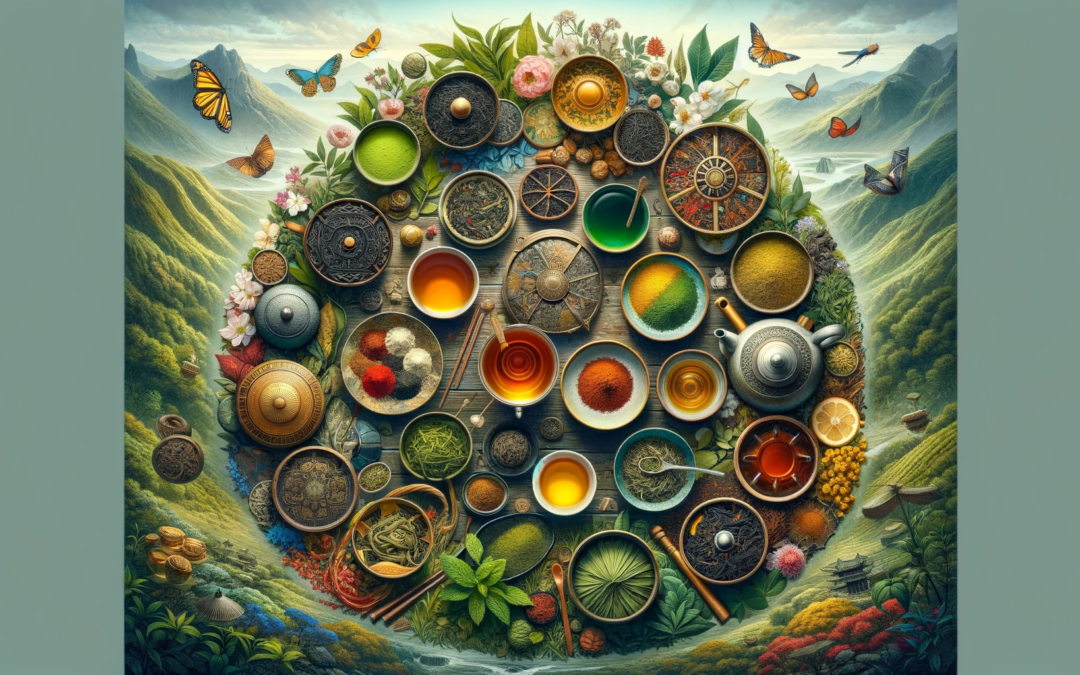Tea, the most widely consumed beverage in the world after water, has a rich and diverse history that spans across continents. Each region offers its unique variety of tea, imbued with local flavors and traditions. From the aromatic estates of India to the tranquil tea gardens of Japan, every cup of tea is a story. This guide delves into the top ten exotic teas from around the world, offering a glimpse into the global tea culture and the unique characteristics of each variety.
1. Japanese Matcha (Amazon)
- Key Features: Vibrant green color, powdered form, umami flavor
- Pros: Rich in antioxidants, versatile in use
- Cons: Requires special preparation tools, can be bitter if overbrewed
- Description: Matcha is a finely ground powder made from specially grown and processed green tea leaves. It’s celebrated for its rich umami flavor and vibrant green color, commonly used in traditional Japanese tea ceremonies.
2. Chinese Pu-Erh Tea (Amazon)
- Key Features: Aged, fermented tea, earthy flavor, loose or compressed form
- Pros: Digestive benefits, unique aging process enhances flavor
- Cons: Acquired taste due to its distinct earthy flavor
- Description: Pu-erh tea is a type of fermented tea traditionally made in Yunnan Province, China. It’s known for its deep, earthy flavor that develops over time and can be enjoyed in both loose-leaf and compressed cake forms.
3. Indian Darjeeling Tea (Amazon)
- Key Features: Grown in the Himalayas, musky-sweet tasting notes, often called the ‘champagne of teas’
- Pros: Distinct aromatic profile, range of flavors based on harvest time
- Cons: High-grade Darjeeling can be expensive
- Description: Darjeeling tea, often referred to as the ‘champagne of teas,’ is grown in the foothills of the Himalayas. It’s renowned for its musky-sweet tasting notes, with the flavor profile varying significantly between first, second, and autumnal flushes.
4. Moroccan Mint Tea (Amazon)
- Key Features: Blend of green tea and mint, served sweetened
- Pros: Refreshing taste, easy to prepare
- Cons: May be too sweet for some palates
- Description: A staple in Moroccan culture, this tea is a refreshing blend of green tea and mint leaves. Traditionally served sweet, it’s known for its revitalizing and soothing properties.
5. South African Rooibos Tea (Amazon)
- Key Features: Red herbal tea, naturally caffeine-free, earthy-sweet flavor
- Pros: Rich in antioxidants, gentle on the stomach
- Cons: Lack of caffeine might not appeal to all tea drinkers
- Description: Rooibos, or ‘red bush’ tea, is a herbal tea native to South Africa. It’s appreciated for its naturally sweet taste and health benefits, being caffeine-free and low in tannins.
6. Taiwanese Oolong Tea (Amazon)
- Key Features: Partially oxidized, range from light to full-bodied flavors
- Pros: Complex flavor profiles, can be steeped multiple times
- Cons: Proper brewing requires attention to detail
- Description: Oolong tea from Taiwan is celebrated for its diverse range of flavors, from floral and light to rich and full-bodied. The partial oxidation process results in a complex flavor profile that evolves with each steeping.
7. Turkish Rize Tea (Amazon)
- Key Features: Grown in the Rize Province, strong black tea, often served with sugar
- Pros: Bold and robust flavor, integral part of Turkish hospitality
- Cons: Can be overpowering if steeped too long
- Description: Turkish Rize tea is a type of strong black tea grown in the northeastern part of Turkey. It’s known for its bold flavor and is a central part of Turkish culture and hospitality.
8. Assam Tea from India (Amazon)
- Key Features: Grown in the Assam region, malty flavor, briskness
- Pros: Strong and energizing, ideal for breakfast teas
- Cons: Can be too astringent for some
- Description: Assam tea, from the northeastern state of Assam in India, is known for its robust, malty flavor. It’s often used as the base for many popular breakfast teas and is best enjoyed with milk.
9. Sri Lankan Ceylon Tea (Amazon)
- Key Features: Grown in Sri Lanka, bright and citrusy notes
- Pros: Versatile flavor profile, can be enjoyed hot or cold
- Cons: Flavor might be too subtle for those used to stronger teas
- Description: Ceylon tea, named after the country’s former name, is a staple in Sri Lanka. It’s known for its bright, citrusy notes, making it a refreshing option either hot or as an iced tea.
10. Chinese Jasmine Tea (Amazon)
- Key Features: Green tea scented with jasmine blossoms, delicate and fragrant
- Pros: Light and soothing, aromatic experience
- Cons: Delicate flavor may not appeal to those who prefer stronger teas
- Description: Jasmine tea is a type of scented tea made by blending green tea leaves with jasmine blossoms. It’s cherished for its delicate, fragrant aroma and is often enjoyed in the evening for its soothing qualities.
Exploring the world of exotic teas opens up a realm of cultural experiences and flavors. Each variety of tea offers a unique glimpse into the traditions and tastes of its region of origin, making every cup a journey in itself. Whether you’re a seasoned tea connoisseur or new to the world of tea, these top ten exotic teas promise to deliver a delightful and enriching experience.











